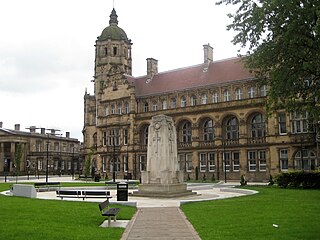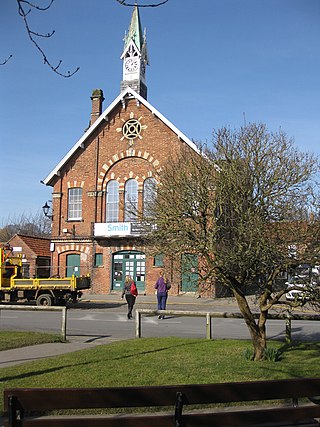
West Yorkshire is a metropolitan and ceremonial county in the Yorkshire and the Humber region of England. It borders North Yorkshire to the north and east, South Yorkshire and Derbyshire to the south, Greater Manchester to the south-west, and Lancashire to the west. The city of Leeds is the largest settlement.

Wakefield is a cathedral city in West Yorkshire, England located on the River Calder. The city had a population of 109,766 in the 2021 census, up from 99,251 in the 2011 census. The city is the administrative centre of the wider metropolitan district, which had a 2021 population of 353,802, the 25th most populous district in England. It is part of the West Yorkshire Built-up Area and the Yorkshire and The Humber region.

Normanton is a town and civil parish in the City of Wakefield in West Yorkshire, England. It is north-east of Wakefield and south-west of Castleford. The civil parish extends west and north to the River Calder, and includes the large village of Altofts. At the time of the 2011 Census, the population of the civil parish was 20,872.

Bradford Cathedral, or the Cathedral Church of St Peter, is an Anglican cathedral in Bradford, West Yorkshire, England, one of three co-equal cathedrals in the Diocese of Leeds alongside Ripon and Wakefield. Its site has been used for Christian worship since the 7th century, when missionaries based in Dewsbury evangelised the area. For many centuries it was the parish church of St Peter and achieved cathedral status in 1919. The cathedral is a Grade I listed building.

John Carr (1723–1807) was a prolific English architect, best known for Buxton Crescent in Derbyshire and Harewood House in West Yorkshire. Much of his work was in the Palladian style. In his day he was considered to be the leading architect in the north of England.

Thornton-le-Dale is a village and civil parish in North Yorkshire, England, about 3 miles (5 km) east of Pickering on the edge of the North York Moors National Park. The area of the village encompasses 39.2 square kilometres.

County Hall or West Riding County Hall stands at the corner of Bond Street and Cliff Parade in Wakefield, West Yorkshire, England. It is the main headquarters of Wakefield Metropolitan District Council. It is a Grade I listed building.

Halifax is a minster and market town in the metropolitan borough of Calderdale in West Yorkshire, England. It is the commercial, cultural and administrative centre of the borough, and the headquarters of Calderdale Council. In the 15th century, the town became an economic hub of the old West Riding of Yorkshire, primarily in woollen manufacture. Halifax is the largest town in the wider Calderdale borough. Halifax was a thriving mill town during the Industrial Revolution. In 2011, it had a population of 88,134.

William Swinden Barber FRIBA, also W. S. Barber or W. Swinden Barber, was an English Gothic Revival and Arts and Crafts architect, specialising in modest but finely furnished Anglican churches, often with crenellated bell-towers. He was based in Brighouse and Halifax in the West Riding of Yorkshire. At least 15 surviving examples of his work are Grade II listed buildings, including his 1875 design for the Victoria Cross at Akroydon, Halifax. An 1864 portrait by David Wilkie Wynfield depicts him in Romantic garb, holding a flower. He served in the Artists Rifles regiment in the 1860s alongside Wynfield and other contemporary artists.

Watford Town Hall is a municipal building in Rickmansworth Road, Watford, England. It is a Grade II listed building.

County Hall in Northallerton, North Yorkshire, England, serves as the headquarters of North Yorkshire Council. The building was opened in 1906 and has also been the headquarters of the North Riding County Council (NRCC) until 1974, and then North Yorkshire County Council until 2023. County Hall is at the south western edge of Northallerton and is a Grade II* listed building.

Kettlethorpe Hall is a Georgian house in Wakefield, West Yorkshire, England. The hall is a Grade I listed building. From 1847 until 1996, the grounds of the hall contained the façade of a 14th-century chapel on the front of a boathouse, which was a Grade II* listed building.

Wakefield Town Hall is a municipal building in Wood Street in Wakefield, West Yorkshire, England. It remains a venue for weddings and civil partnerships but is no longer the headquarters of Wakefield Council which is now based at County Hall. The town hall is a Grade I listed building.

Elland Town Hall is a municipal building in Southgate, Elland, West Yorkshire, England. The structure, which was primarily used as an events venue, is a Grade II listed building.

Easingwold Town Hall is a municipal building in the Market Place in Easingwold, North Yorkshire, England. The structure was used as an events venue and is now used as a commercial printing centre, producing The Easingwold Advertiser & Weekly News.

Thirsk and Sowerby Town Hall is a municipal building in Westgate, Sowerby, North Yorkshire, England. Although it is commonly described as being in Thirsk, it is on the south side of Westgate, which is in Sowerby. The building is used as the meeting place of Thirsk Town Council and of Sowerby Parish Council.

Kirkgate is a street in the city centre of Leeds, in England.

Kirkgate is a street in the city centre of Wakefield, in West Yorkshire, in England.

Northgate is a street in the city centre of Wakefield, in West Yorkshire, in England.

The Old Town Hall, also known as 1 High Street, is a former municipal building and historic building in the High Street, Tadcaster, North Yorkshire, England. The structure, which now forms part of the headquarters of Samuel Smith's Brewery, is a grade II listed building.





















